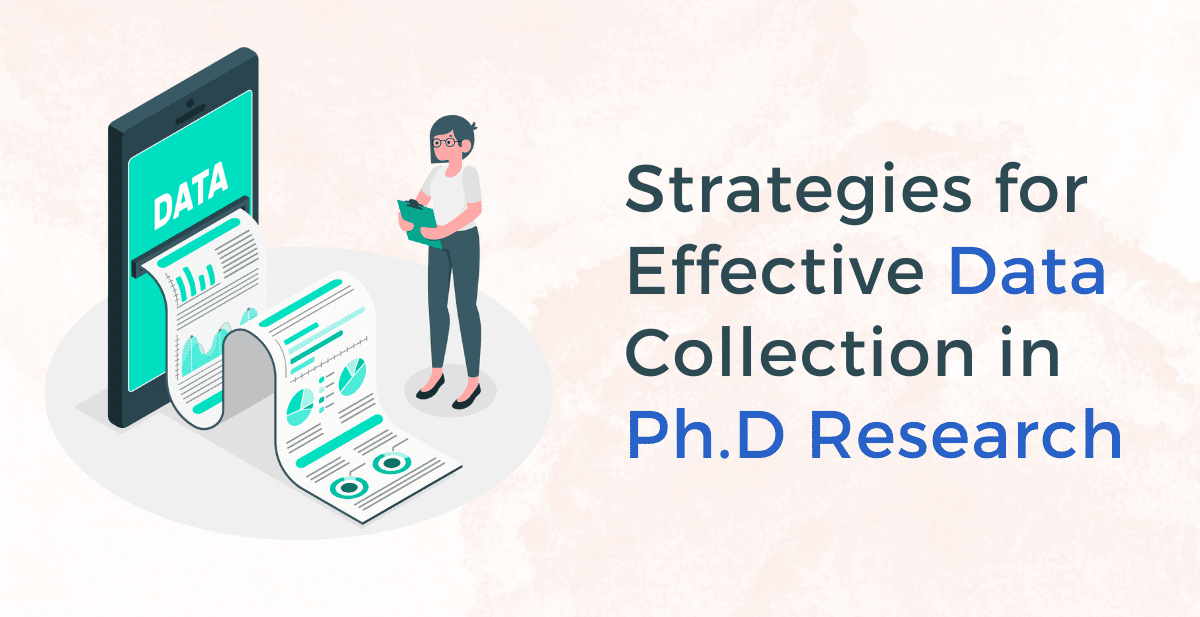- June 12, 2024
- by IdeaLaunch
- Ph.D. Guidance, PhD Research Proposal, Research Projects
Strategies for Effective Data Collection in PhD Research
The progression of congregation, exploratory, and evaluating innumerable practises of data employing a range of acknowledged, tried-and-true techniques gives its name data collecting. The key objective of collection of data is to obtain reliable, thorough data, which is subsequently evaluated to support key business choices. After the data is collected, an extensive procedure of data handling and information cleaning must be carried out in order to make the data genuinely useful for companies.
There are two main methods for collecting data in research, depending on the information required, and they are as follows:
- Primary Data Collection
- Secondary Data Collection
1. Primary Data Collection
Primary data are those that are obtained by direct observation from the primary source. It makes references to never-before-used information. Data obtained through primary techniques of data collection are the best kind of data for research. Raw data gathering methods could be divided into twofold groups: method emphasizing the numerical analysis that work with attributes which may be tallied, and qualitative procedures, which delves into qualities that aren’t constantly arithmetical in nature.
Techniques for gathering primary data:
These are a few of the most popular techniques for gathering primary data:
Interviews
Interviews are one simple method of data collection. They are merely a question-and-answer session between the interviewee and the interviewer. This method proposes a profusion of adjustability because queries might always be amended to suit the surroundings.
Observations
This tactic allows researchers to monitor their atmosphere and manuscript their observations. It is helpful to measure how innumerable characters perform in either regulated (where onlookers are cognisant of their involvement) or unrestrained (where onlookers are ignorant of their occurrence) scenarios. This technique is effective since it is straightforward and doesn’t directly depend on other participants.
Surveys and opinion
Surveys and opinion pieces provide an extensive perspective from large numbers of people. Responses may have been sent, published online, or even gathered in person to gather input from individuals worldwide. Answer options include a combination of choices, correct or incorrect, open to interpretation, and yes/no. But surveys and questionnaires have drawbacks as well, like long response times and the potential for unclear responses.
Focused Groups
Despite the fact a focus group is held with an array of people who share similar interests, it functions similarly to an interview. While the data gathered is comparable, they offer a better understanding of the motivations behind the cognitive processes of a particular set of people than in-person interviews. However, this technique has significant drawbacks, such as the loss of privacy and the domination of one or two individuals during the interview. Focus groups can produce some of the most insightful counsel for complex situations, despite being challenging and time-consuming.
Using Oral Histories for Event-Specific Research
Similar questions from interviewing and conducting focus groups are also included in oral histories. Despite this, it is more precisely defined, and the data collected is associated with a specific event. It is getting to know people’s opinions and first-hand recollections of the activities they have taken part in. For example, it can be helpful to analyze the impact of a new product on a certain population.
2. Secondary Data Collection
Secondary data is information that has previously been obtained by another entity. It is significantly less expensive and far easier to collect than original data. Even though first-hand information gathering yields more authentic and unique data, there are a number of circumstances in which gathering additional information offers businesses substantial advantages. Some of the most widely used methods for obtaining secondary data are listed below:
Techniques for gathering Secondary data:
Utilizing the Internet for Data Collection
The Internet has become a widely utilized auxiliary collection of data strategy in recent times. Numerous paid and free research resources are easily accessible via the Internet. Even though this method of data collection is quick and easy, you should only get information from trustworthy sources.
Leveraging Government Archives for Data Collection
A multitude of data is accessible from government archives that you can utilize. The main advantage is that information contained in official archives can be verified and is authentic. However, the issue is that data isn’t always readily available for a number of reasons.
Utilizing Library Resources for Scholarly Research
Most scientists donate multiple editions of their scholarly publications to libraries. You can obtain important and trustworthy information by taking into account a number of study conditions. Libraries also store annual reports, corporate directories, and other documents that help businesses in their research.
Get a free consultation:
Contact us for comprehensive Ph.D. guidance: we offer services in proposal writing, Ph.D. article writing with publications, thesis writing, synopsis writing, proofreading, editing, research data analysis and full Ph.D. support. Call or WhatsApp us today for a free consultation.








